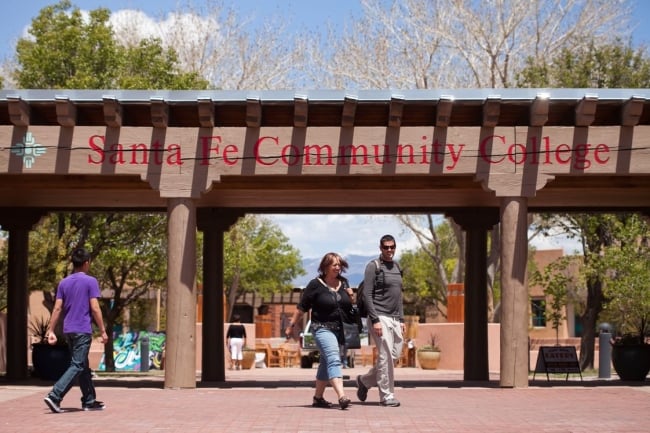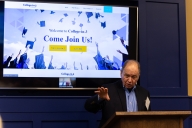You have /5 articles left.
Sign up for a free account or log in.

Two-year institutions like Santa Fe Community College were responsible for the brunt of enrollment recovery since last spring, but head counts are still far below pre-pandemic levels.
Santa Fe Community College
After two years of free-falling college and university enrollments, head counts seem to be settling into a slow descent, according to a new report on spring enrollment data from the National Student Clearinghouse Research Center.
Over all, enrollments declined by 0.5 percent across all higher ed sectors since spring 2022, according to the report. That’s a much smaller drop than the 3.1 percent decline from spring 2021 to spring ’22. But a drop is a drop, and when compounded by two years of steep declines during the COVID-19 pandemic, hopes for a full or even partial recovery seem out of reach for most institutions.
“The spring data confirms that enrollments are stabilizing. But it’s important to note that we’re stabilizing nationally at a level far below pre-pandemic levels,” Doug Shapiro, director of the NSCRC, told reporters during a press briefing Tuesday. “We have nearly 1.2 million fewer students than in 2019.”
The NSCRC report found that enrollment in bachelor’s degree programs was down 1.4 percent from spring 2022, with public four-year institutions responsible for the bulk of the decline: 0.5 percent, compared to 0.2 percent at private four-year colleges. Meanwhile, community college enrollments are up by 0.5 percent, a trend that began in the fall as they started to climb back from a staggering 10 percent dive during the pandemic.
The trend lines haven’t changed much from the NSCRC’s fall 2022 enrollment numbers, which showed declines slowing but not reversing and community colleges carrying the bulk of what little recovery there was.
Age disparities are also an increasingly important part of enrollment trends. Enrollment among students under the age of 18—mainly dual-enrolled high school students in community college classes—climbed by 8.2 percent from spring 2022, while the share of traditional-age students rose by 0.3 percent and students over 24 declined by 3.3 percent.
Shapiro added that as the pandemic fades into the background, new challenges are keeping enrollments from surging back to pre-pandemic levels. They include rising tuition costs, anxieties about student debt and growing doubts about the value of higher education in general—factors that he worries could have a more lasting impact than COVID-19.
That prediction isn’t very different from the grim outlook Shapiro shared with Inside Higher Ed a few weeks ago after a panel event called “Bouncing Back From the Enrollment Plunge.” When asked if he saw any new or emerging signs of recovery beneath the surface of the spring enrollment data, Shapiro reiterated his pessimism about traditional enrollment strategies and urged institutions to begin adapting to a new landscape.
“When we look at expected declines and demographic shifts, that’s really concerning for colleges who are trying to stay afloat,” he said. “They’re not going to find traditional-age students to fill those seats.”
Community Colleges’ Dual-Edged Sword
The growth in community college enrollments was buoyed by certificate programs, in which enrollment has surged by 5 percent since last spring, and by dual enrollment among high school students, up 8 percent.
John Fink, a senior research associate at the Community College Research Center of Teachers College at Columbia University, said that’s a promising sign—as long as institutions can convert those interested high schoolers to degree-seeking students on their campuses.
“To some extent, dual enrollment is sort of keeping up or keeping stable those community college enrollments right now, which is not sustainable,” he said. “Institutions need to figure out how to make dual enrollment an on-ramp to college.”
Meanwhile, the number of degree-seeking students is falling as enrollments shift toward short-term certificate and credential programs: while associate degree seekers fell by 0.2 percent at two-year institutions since last spring, non-degree-seeking enrollees rose by 2.3 percent. That follows a much steeper decline among associate degree seekers during the pandemic—11.5 percent from 2020 to 2021 and 10.3 percent the following year —than among short-term program enrollees, whose declines remained in the single digits.
Shapiro attributed the shift to a growing hunger among students for a quick and direct pathway to employment, rather than investing in a more expensive and time-consuming degree.
For Fink, the issue preventing community colleges from recovering more completely is not just demographic drop-off or value skepticism; it’s primarily about cost and accessibility. Remedying that, he said, requires institutions—especially neighboring regional ones—to see themselves as collaborators more than competitors.
“We have a college access crisis right now,” Fink said. “Community colleges and their four-year partners need to step up and take responsibility for the talent being wasted in this transition from high school to college.”
The Start of a ‘New Era’
Shapiro said the “most promising signs of recovery” in the spring data are concentrated among dual-enrolled high schoolers and traditional-age college students, while “older students continue to disappear from campuses across all sectors.” However, he was quick to add that this trend is likely to reverse in the next few years.
Shapiro pointed out that higher ed is probably experiencing the first effects of a short-term bump in traditional-age head counts predicted by the Western Interstate Commission for Higher Education in 2019, before the onset of a demographic plunge. But WICHE’s projection—a 4.5 percent increase from 2023 to 2026—was made before the pandemic set enrollments back even more. Shapiro said relying on that blip for short-term gains could come at the detriment of more important long-term restructuring.
“I don’t think anyone can predict the future, but I do think colleges and universities need to think differently about the types of students they can enroll and the types of programs they can offer to bring different types of students in,” Shapiro said. “I would encourage institutions not to focus so much on the short term if it’s distracting from that.”
Megan Brewster, director of strategy at the Sorenson Impact Center, a strategic data initiative at the University of Utah, helped launch an interactive dashboard for college leaders to predict and respond to enrollment and demographic trends last month. She said that while the general enrollment trajectory seemed to be in for more declines before any increases, that presented an opportunity for an exciting paradigm shift.
“Higher ed is entering a new era. The assumptions that could be made in the past, those certainly aren’t going to hold true for the future. But there is opportunity that comes with those challenges,” she said. “Demographics aren’t destiny. Universities just need to wake up and pay attention, develop proactive strategies to serve and attract new types of students, because this is the new reality.”









